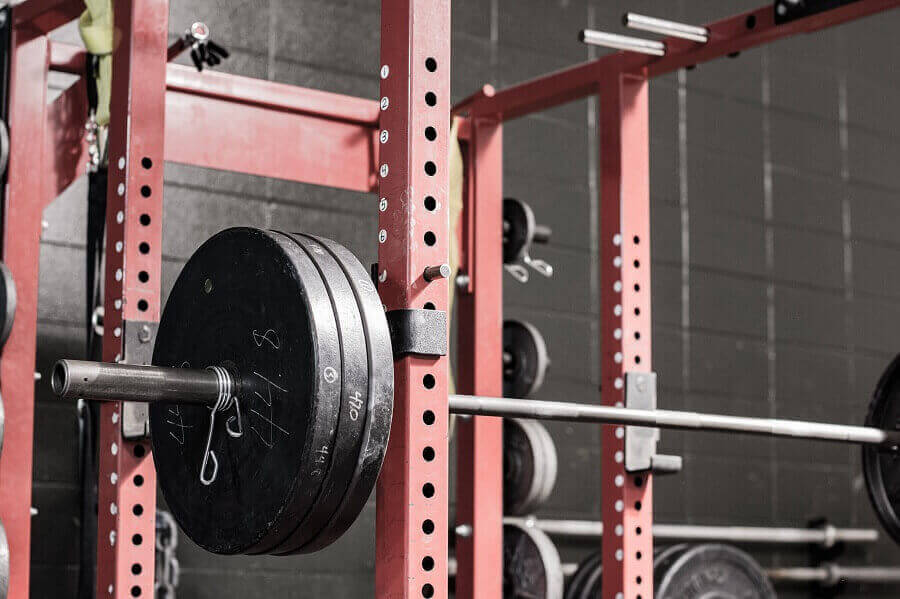Olympic Masters weightlifting champion Dr. Doug Briggs stops by to drop some squat wisdom. Here are 8 tips to develop a stronger and more powerful squat.

The squat.
Beyond just being a leg exercise it is possibly the most functional movement you can do in the gym. Doing squats will not only helps develop muscle mass body-wide, but help you jump out of the armchair with power and speed.
Doug Briggs, Ph.d, CSCS, is a 2x Masters Olympic Weightlifting Champion and 2x Masters Pan-American Olympic Weightlifting Champion, and author of “Built for Strength” drops by to share some knowledge for the next time you step into the power rack.
1. Squatting 101.
- Buy a good pair of weightlifting shoes (not cross training shoes) with a solid heel. I like Adidas Olympic weightlifting shoes. Tennis/athletic/running/cross training shoes suck. (For more squat shoes, check out this breakdown of the best squatting shoes on the market right now.)
- Grab the bar, arch your back and pull your scapula together (pinch it together) and place the bar lower in the groove of the traps. This is a low bar squat vs. a high bar squat which is more typically seen in Olympic weightlifting.
- Have a hip to shoulder width stance with your toes pointed out slightly.
- Stand tall, look straight ahead, not up and inhale deeply, start your descent.
- Sit back and go ALL the way down, butt to the ankles if you have no knee problems.
- ALL the way down means a full range of motion (ROM) which will prevent injuries.
- Start your ascent by driving through your heels and sitting back.
- Come all the way up and repeat or rack the bar if it is a 1-rep set.
- Stay tight all the way through the movement. You shouldn’t be like Gumby when the bar is loaded and you are preparing to squat.
2. Never use a “sissy” pad on the bar. This is what shoulder adduction is for as it give the traps and lower shoulder muscles the necessary padding to keep the bar off of your spine.
3. Use a belt strategically. Never use a weightlifting belt until you are doing 1 or 2 reps with 90+ or your one rep max. Using a belt at lower weights will weaken your core muscles.
4. Don’t bounce out of the “hole” at the bottom. Control the weight from start to finish by being “tight”.
5. Never stretch before weightlifting, it decreases muscular power by up to 8%. Do a dynamic warm-up first by squatting for 10-reps with an unloaded bar and working your form. A good 5-10 minute warm-up is the perfect way to start as you will elevate your core temperature, lubricate the joints and prepare the body for exercise. Grab a jump rope, add a couple of quick plyometric box jumps–get yourself moving and get yourself primed for lifting success.
See also: 5 Best Pre-Workout Stretches for Leg Day
6. Never round your back or let your knees cave-in when squatting. Both will lead to injury.
7. Never place a board or weight plate under your heels. If you do not have the flexibility (mobility) in your ankles, work on flexibility first and then squat all the way down.
8. Pause at the bottom. With a weight you can handle, come to a complete stop at the bottom of the lift and then drive out of the hole. This does wonders for strength. I always do this on the last rep in a set.
Shout-out to Doug for stopping by to share his knowledge. You can catch up with Dr. Briggs online by visiting his website.
More Squat Info:
Go Ballistic: Why You Should Add Jump Squats to Your Training. Want to improve your squat? Increase the speed and power in your legs? Become a better athlete? Then you my friend should cozy up to your new best-buddy-old-pal, the jump squat. Here is why and how to add it to your program.
Sprint Athletes: Do Quarter Squats for Speed and Power. Want to improve your vertical jump and 40-yard dash? New research shows that when it comes to developing speed and power quarter squats is the way to go.
Squat Pyramid: How to Crank Up Your Squat. Not for beginners, this squat pyramid that powerlifter and strength coach Will Ruth will leave your legs quivering.
Best Squat Wedges for Better Squats. Improve range of motion and muscle recruitment with squat wedges, your ultimate tool for full range of motion when squatting.
5 Best Squat Shoes for Women (and Why You Should Be Wearing Them). The right squat shoes protect your ankles, help you squat with better form, and help you lift more weight. Here’s a breakdown of the best squat shoes for women.